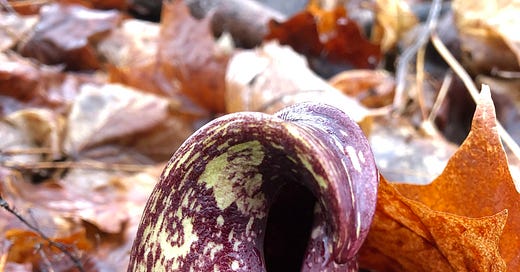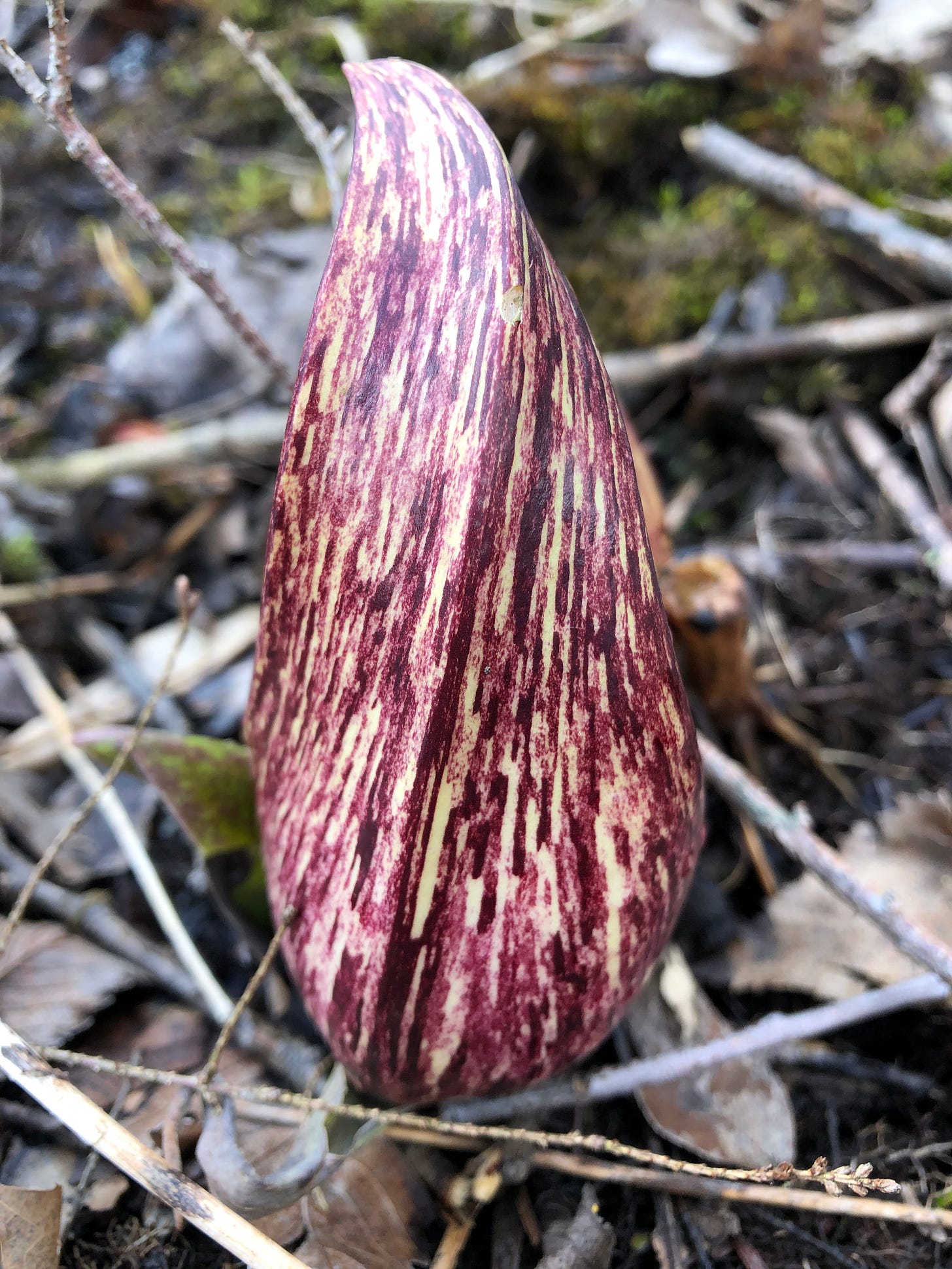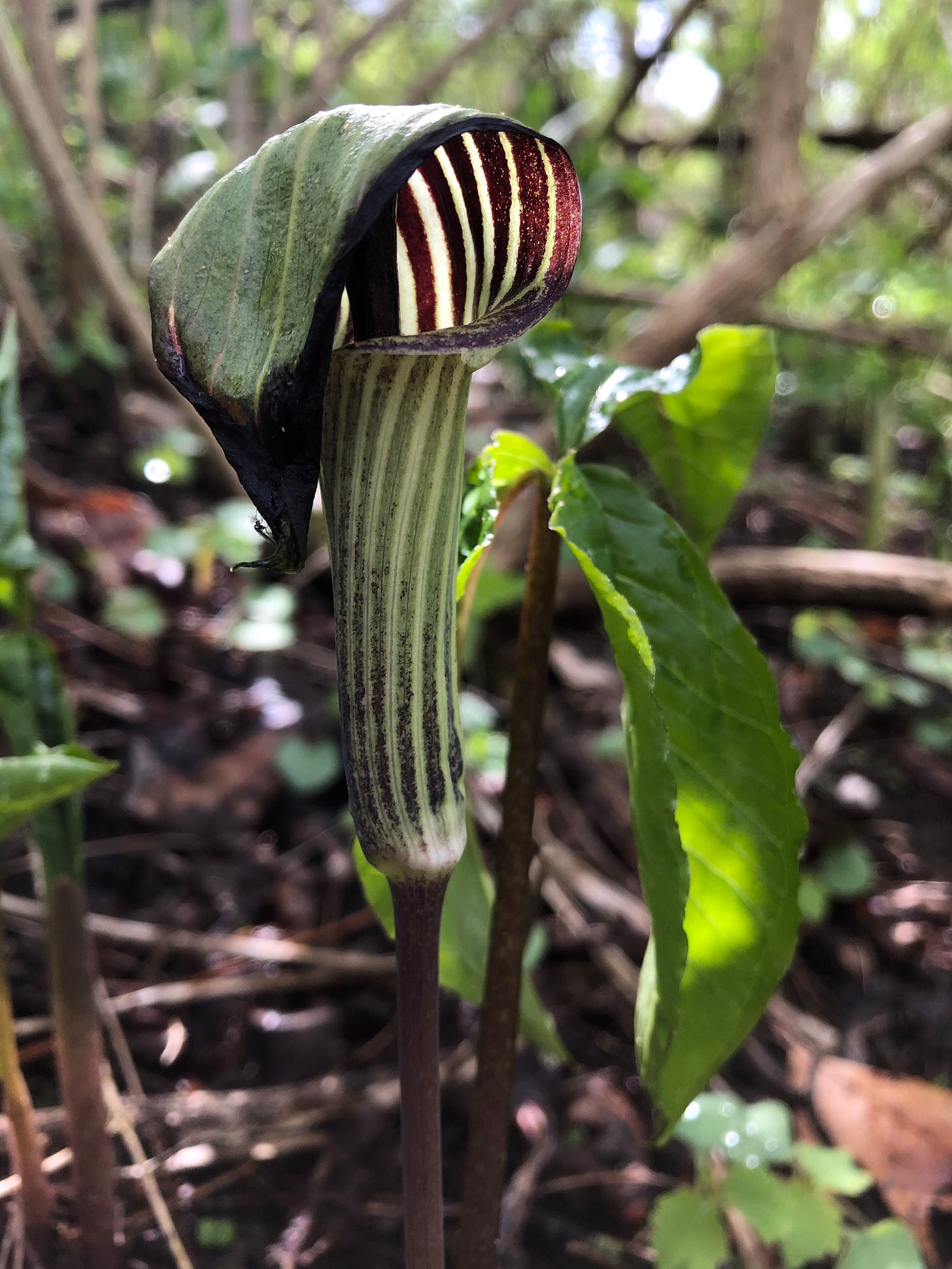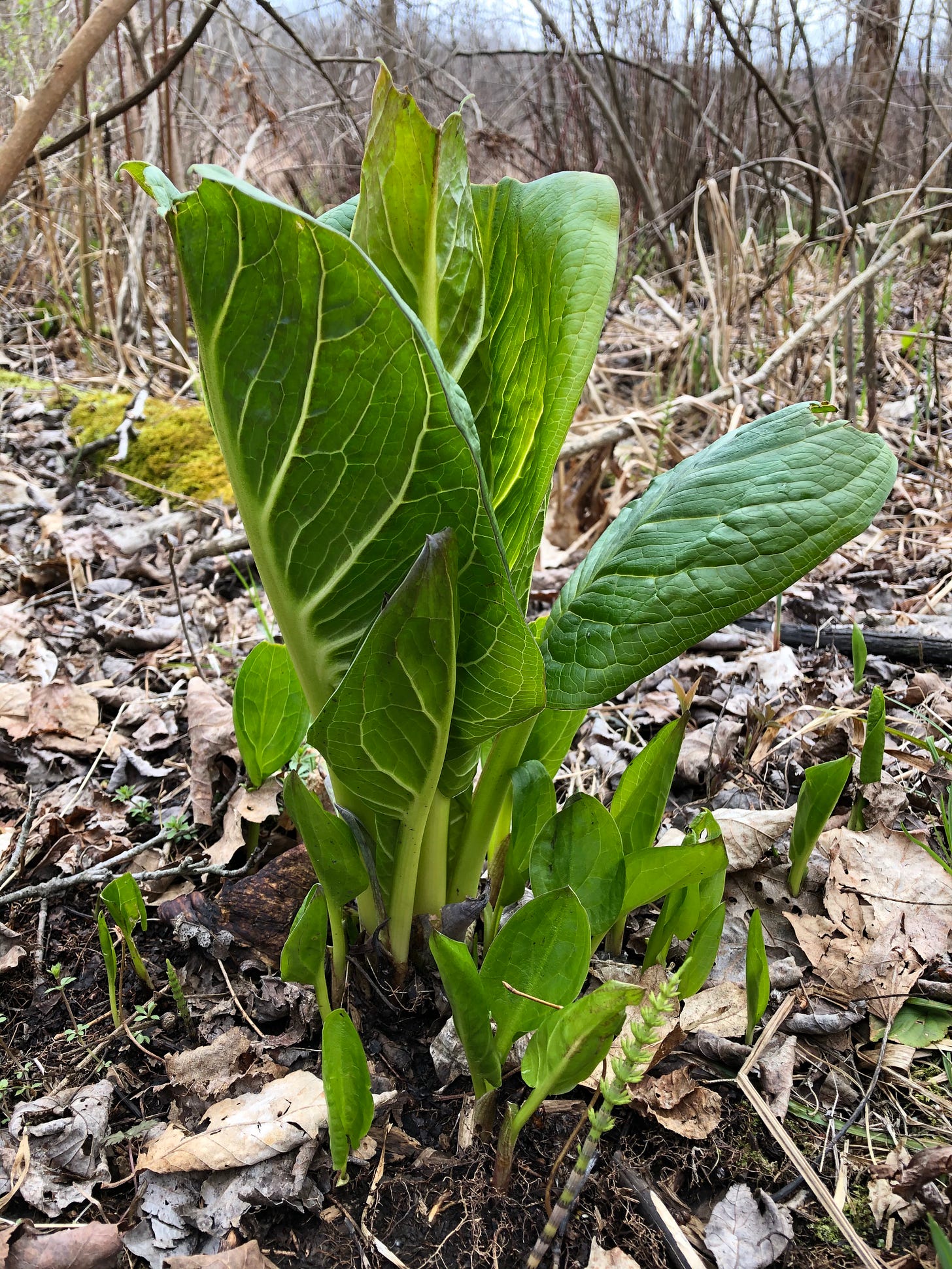Before I get into the botany of these eery swamp-dwellers, I want to let you know that this Sunday, March 10th we have our first fb community plant walk at Drowned Lands Swamp in Ancramdale. We’ll be meeting at 10 am, we’ll walk about 2 hours together, and commune with the plants we find there, we’ll be focusing on the early signs of spring emerging, including the Skunk Cabbages.
This is the first in a season of many walks to come, these walks are the heart & soul of Foliage Botanics and if you read last week’s missive you understand why I care so much about them. All community plant walks cost $20, but no one is turned away. Anyone who has more to give is encouraged to do so to contribute to our “pay it forward” fund that enables others to come for less and bolsters our ability to offer scholarships for foliage classes to trans students and students of colour. To rsvp for the walk just hit reply or email me at foliagebotanics@gmail.com and I’ll send you more details by the end of the week.
On to the Skunk Cabbages!
Skunk Cabbages are a true harbinger of spring here in New York and are one of my favourite wildflowers. And yes! They are flowers! Every year around this time, as winter begins to dissipate, snow and ice melts, birdsong returns, I get this feeling inside me, like clockwork, my own inner awakening at the subtle changes in sounds and light and smells, a great excitement and rekindled energy for spring, like something that was stagnant is coursing through me once again. Of course I wake up and run half-dressed to the creek’s edge to see who has begun to poke through, lifting up the duff, overturning hepatica leaves, chewing on the first tendrils of wild onions, hungry for life.
The wetlands and low places are always where these early spring risers are found and though it’s early March still and very little has emerged, the Skunk Cabbages do not disappoint. They seem to have no sense that there might yet be wintery weather and frost and appear in spite of it all, like clockwork, hardy enough to blast right through snow and ice. In fact, Skunk Cabbages produce heat, a process called thermogenesis. Did you also know that the colour purple is actually more stable than green in the cold? This is why so many of our early spring herbaceous plants are this deep anthocyanin-rich colour, even plants that eventually turn green, like Nettle. It’s a protective mechanism that enables them to endure lower temperatures. Essentially, Skunk Cabbages are designed to thrive on the unpredictable cusp of the season and to take advantage of a time when very little else (honestly, absolutely nothing but maybe the maples) is blooming.
Botanically, Skunk Cabbages are pretty unique. Distinguished by their “spadix” and “spathe” structure, they don’t really look like a flower compared to what we are commonly most familiar with, the perfect petal structures and attractive smells, but this is a feature of most flowers in the Arum family, to which Skunk Cabbage belongs. Calla lilies and Jack-in-the-Pulpits are just a few commonly known Arum family plants that also have the spadix/spathe flower.
The spathe is the thick, shiny, hood-like feature that forms the most obvious part of the Skunk Cabbage plants. This is actually a specialized bract, a leaf-type structure associated with flowers, and it is often quite showy and colourful. The Skunk Cabbage spathe is a gorgeous mottled purple & yellow, like an ethereal water colour painting, sometimes all purple or even mostly lime green. The patterning is so unusual, unobtrusive underfoot, but also just incredibly eye-catching and often very different plant to plant. I like to photograph the more beautiful ones I find and have quite a collection. Much like the showy petals of summer flowers, I think of the spathes like little landing pads or holding devices for the pollinators this plant is trying to attract—along with its stinky, skunk-like scent! The insects are lured inside this dark colourful cave and there the true floral sweetness awaits.
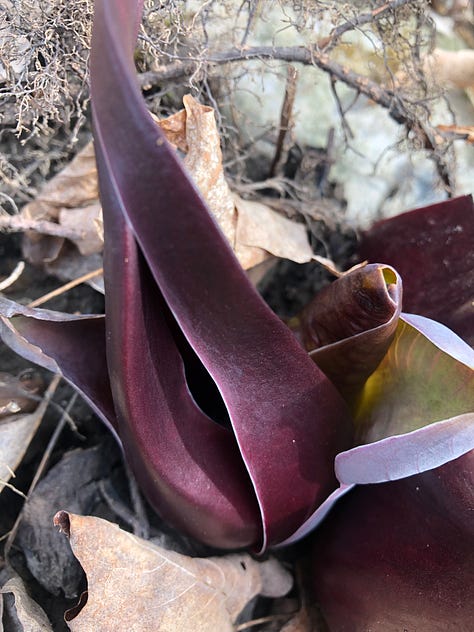
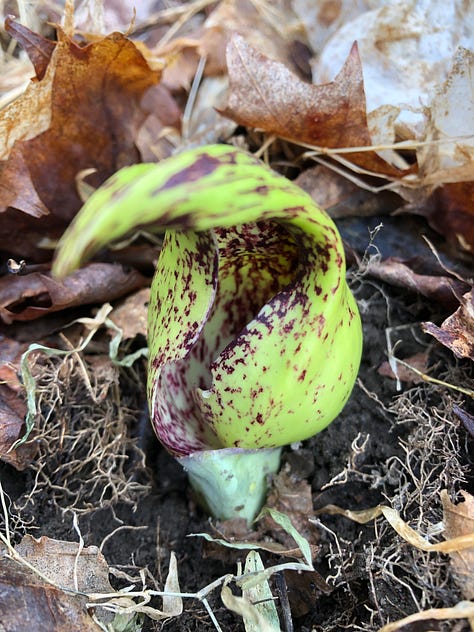

The spadix sits inside the spathe, a tiny ball that looks a bit like a weird brain or a microscopic virus. When inspected closely, this strange ball is a collection of many individual flowers, an inflorescence, all fused together on a common receptacle, visible in little hexagonal segments. There are about 50-100 bisexual flowers fused together there, each segment with its own tiny pistil and stamen—the pollen & seed-producing parts—emerging from their centre. In fact, if you peel back the spathe during full bloom, you will often find a collection of yellow pollen at its base.
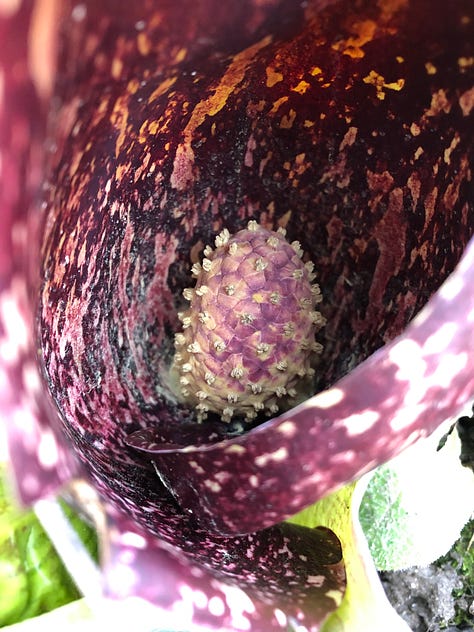
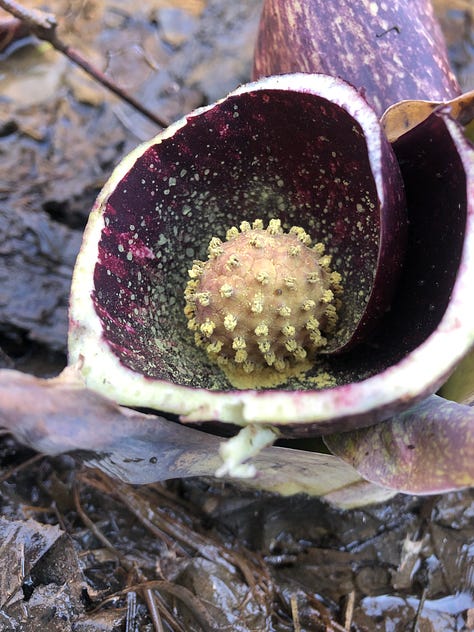
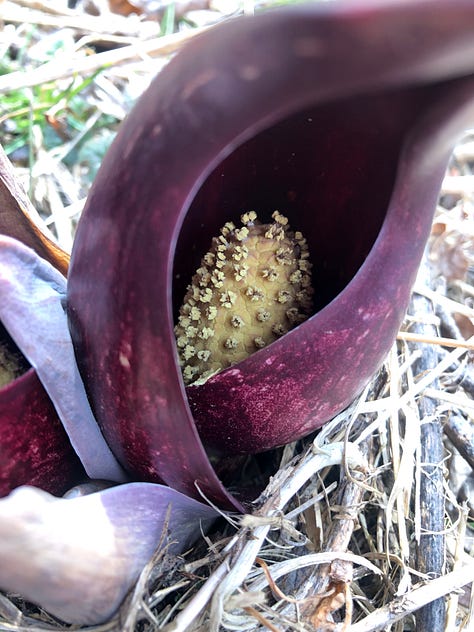
Like many of our early spring plants, the flowers emerge first and the leaves only really unfold after the flower has senesced. The leaves themselves are a deep waxy green, round, and persist through the summer to photosynthesize before dying back. Despite the name, this plant and its leaves should not be eaten. The root of Skunk Cabbage is historically medicinal, used by the indigenous people on turtle island for respiratory issues and then brought into western pharmacopoeia, but it isn’t used much medicinally today and I don’t advise it.
Last week I wrote about the importance of names and I think this plant’s names really exemplify it and serve us in our plant identification. The common name—Skunk Cabbage—elucidates both its pungent aroma (just walk through a skunk cabbage patch and you’ll surely smell it) and the way the leaves look a lot like cabbage. In the botanical name, the genus—Symplocarpus—basically means many fruits together (think symphony or symbiotic), which the flower eventually produces, and the species—foetidus— refers to its “fetid” rotten smell, which insects find very enticing.
So, while you are out on your woodland romps in search of early signs of spring, head into the lower, damp places in the forest and see if you can spot these funky friends. Try peeling back the spathe and examining the unique spadix flower within! I assure you it will fill your cup. And join us on the trail this Sunday at 10—we will be hunting for Skunk Cabbages and Hazelnut flowers, examining tree barks and spotting birds in the swamp and gosh I think even maybe the frogs will be out.
from my spring-hungry heart to yours
x hannah


